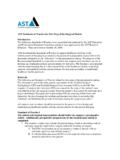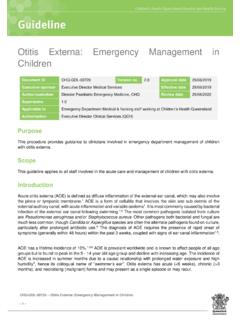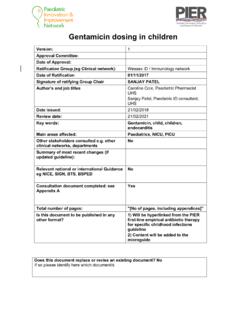Transcription of Audiometry Procedures Manual - Centers for Disease Control ...
1 Audiometry Procedures Manual January 2005. TABLE OF CONTENTS. Chapter Page 1 INTRODUCTION .. 1-1. History and Overview of Hearing Examinations in 1-1. Basic Principles of Sound .. 1-5. Basic Principles of Audition .. 1-8. Basic Principles of Hearing 1-11. REFERENCES .. 1-13. 2 EQUIPMENT .. 2-1. Description of Exam Room in 2-1. Description of Equipment and Supplies .. 2-2. 2-9. Tympanometer .. 2-9. 2-9. Bioacoustic Simulator .. 2-10. Sound Level Meter and Accessories .. 2-10. Start of Stand 2-11. Room 2-11. Start of Stand Calibrations .. 2-13. Recording Serial Numbers .. 2-14. Calibration 2-15. Bioacoustic Simulator Calibration Check .. 2-15. Tympanometer Calibration Check.
2 2-17. Audiometer Calibration Checks .. 2-20. Troubleshooting Calibration Problems .. 2-37. Environmental Noise Survey .. 2-38. Environmental Noise 2-38. Environmental Noise Survey Procedure .. 2-39. Daily Monitoring of Ambient Noise Levels .. 2-42. Daily 2-42. Set Up and Calibration .. 2-42. Changing Equipment After Start of Stand .. 2-43. Procedures at the End of an Exam 2-44. iii TABLE OF CONTENTS (continued). Chapter Page Weekly Procedures .. 2-44. Equipment Care and Maintenance Procedures .. 2-45. Sound Level Meter and Accessories .. 2-45. Bioacoustic Simulator .. 2-47. 2-48. Tympanometer .. 2-50. 2-52. End of Stand 2-52. End of Stand Calibrations.
3 2-52. Room 2-53. Guidelines for Packing Audio Equipment .. 2-54. 3 EXAMINATION PROTOCOL .. 3-1. Eligibility Criteria .. 3-1. Pre-examination Procedures .. 3-1. Preliminary Activities .. 3-1. Pre-Exam Questionnaire .. 3-2. Otoscopy .. 3-6. Purpose of Otoscopy .. 3-6. Instrumentation for Otoscopy .. 3-6. Procedure for 3-6. Recording Results of 3-9. Acoustic Immittance .. 3-12. Purpose of Acoustic Immittance .. 3-12. Instrumentation for Acoustic Immittance .. 3-13. Procedure for Acoustic 3-13. Recording Results of Acoustic 3-16. Troubleshooting Acoustic Immittance .. 3-17. Audiometry .. 3-18. Purpose of Audiometry .. 3-18. Instrumentation for Audiometry .. 3-19.
4 Procedure for 3-19. Recording Audiometry Results in 3-28. iv TABLE OF CONTENTS (continued). Chapter Page Retesting with Insert 3-29. Recording Retest Results in ISIS .. 3-31. Considerations to Ensure Threshold Accuracy .. 3-31. Difficult Test Situations .. 3-32. Troubleshooting Audiometry .. 3-35. Post-Examination Procedures .. 3-36. Closing the Hearing Exam in ISIS .. 3-36. 3-37. Directions to Examinee .. 3-38. Final 3-38. 4 QUALITY 4-1. Quality Control Procedures .. 4-1. Review of Data .. 4-2. Field Observations .. 4-2. List of Tables Table 1-1 Review of NHANES audiometric Procedures .. 1-2. List of Figures Figure 1-1 Schematic representation of sound propagation.
5 The small dots in the top of the diagram represent air molecules moving back and forth from their resting position, creating pressure waves. The lower part of the diagram depicts the pressure wave graphically. (From Suter Hearing Conservation Manual , 3rd Edition. Council for Accreditation in Occupational Hearing Conservation, Milwaukee, 1993.).. 1-5. 1-2 Sound levels of various activities. The intensity of the sound is shown in micropascals on the left and decibels on the right. (From Suter Hearing Conservation Manual , 3rd Edition. Council for Accreditation in Occupational Hearing Conservation, Milwaukee, 1993).. 1-7. 1-3 Schematic diagram of the ear. (From Suter Hearing Conservation Manual , 3rd Edition.)
6 Council for Accreditation in Occupational Hearing Conservation, Milwaukee, 1993).. 1-9. v 1. INTRODUCTION. History and Overview of Hearing Examinations in NHANES. Hearing is important. It is the sensory channel by which we are connected to other people, warned of impending dangers, and entertained by music and laughter. Good hearing enables us to perceive the laughter of friends, the cries of a baby, and the breeze rustling through the trees. Without it, we feel isolated from the world around us, and frustrated by our inability to fully understand the flurry of activity that surrounds us. Man is a social creature, and hearing is critical to his ability to function as such.
7 Hearing loss is a widespread problem. According to the National Institute on Deafness and Other Communication Disorders (NIDCD), more than 28 million people in the United States have some degree of hearing impairment. The prevalence of hearing loss increases with age. Two or three out of every 1,000 children born in the are deaf or hard-of-hearing. Approximately 17 out of every 1,000. children under age 18 have a hearing loss. About one-third of Americans over age 65 and nearly half of those over age 75 have significant hearing trouble. An estimated ten million Americans have hearing loss caused by overexposure to noise, which is a completely preventable problem.
8 Only about twenty percent of individuals who could benefit from a hearing aid actually use one. In addition, at least 12 million Americans have tinnitus (ringing in the ears), a condition which can be as disabling as hearing loss. At least one million of these experience tinnitus so severely that it interferes with their daily activities. Hearing loss can be caused by a myriad of factors age, noise exposure (occupational or recreational), developmental syndromes, infectious Disease , physical trauma, ototoxic drugs and chemicals all of which are further influenced by genetic susceptibility. Hearing loss is an invisible . impairment; that is, there are usually no obvious external signs of the damage that is done.
9 In children, it often goes undetected for some time while parents, educators, or health professionals mistake the signs of hearing difficulty for behavior problems or learning disabilities. In older individuals, hearing loss usually develops gradually and insidiously over time. Because of this, hearing loss is frequently misinterpreted by the individual as mumbling by others or getting used to sounds. Others often misinterpret someone's hearing difficulty as inattentiveness or dementia. Often, extensive and irreparable damage has been done to the auditory system before it is noticed. 1-1. The National Center for Health Statistics (NCHS) has regularly included evaluations of the auditory system in its health examination surveys.
10 These evaluations have included one or more of the following: a brief medical examination of the ear, interview questions regarding hearing ability and ear diseases, tympanometry (a test of middle ear function), pure tone air conduction thresholds, pure tone bone conduction thresholds, and/or speech discrimination testing. Sometimes these evaluations were done on all NHANES examinees, and some surveys included hearing evaluations on only a subset of examinees (such as children or adults). Table 1-1 summarizes the audiometric Procedures included in each of the health examination surveys since 1960: Table 1-1. Review of NHANES audiometric Procedures Pure tone testing Bone 1000.















